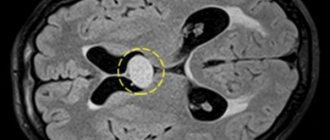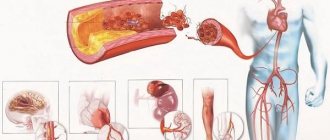Impaired blood supply to the brain with cervical osteochondrosis can have serious consequences. Compression of the blood collaterals of the cervical-collar zone leads to oxygen starvation of the most important parts of the brain and is the cause of arterial hypertension, deterioration of coordination and an increased risk of hemorrhage. Treatment of cerebral circulation in cervical osteochondrosis includes vascular drugs.
The essence and symptoms of circulatory disorders in osteochondrosis
The arteries of the spine pass through the transverse processes of the vertebrae of the neck, washing them with blood: the medulla oblongata, the brainstem, the cerebellum, the occipital lobes, and the inner ear. The medulla oblongata contains centers that coordinate vital functions: arterial tone, heart rate, breathing and swallowing. With cervical osteochondrosis, compression of the arteries occurs, as a result, insufficient blood flow to important areas. Blood circulation is limited and is a consequence of the occurrence of syndromes that determine the symptoms of insufficient blood flow:
At the top of the comments feed are the last 25 question-answer blocks. Galina Pivneva, higher education majoring in Human Health, teacher of Fundamentals of Health, answers questions under the nickname Admin.
We publish responses to comments once a week, usually on Mondays. Please do not duplicate questions - they all reach us.
Poor blood circulation in the brain with cervical osteochondrosis occurs as a result of compression of the blood vessels through which oxygen and important metabolic products are transported. The condition is a common cause of transient attacks, strokes, and encephalopathies.
Causes of circulatory disorders
The pathological condition develops under the influence of unfavorable factors: spinal injuries, infectious diseases of the spinal cord, brain, and hereditary predisposition. Osteochondrosis contributes to the appearance of degenerative lesions inside the discs between the vertebrae. Osteophytes grow on the bone tissue, which compress arteries and veins. As a result, there is a disruption in blood supply and outflow of venous fluid from parts of the brain.
Each segment of the spine is responsible for the stable functioning of certain areas. The cervical vertebrae regulate the activity of the shoulder girdle and brain structures. Regulation occurs due to nerve fibers and blood vessels. If they are pinched, the body suffers from unstable functioning of internal organs or limbs.
The vertebral artery and its branches are responsible for the blood supply to the brain. Minimal changes in the vertebrobasilar region threaten insufficient oxygen supply. Over time, the condition causes a stroke.
Symptoms
With destructive changes in the cartilage of the vertebral discs, cerebral circulatory disorders have a number of clinical signs:
- Radicular syndrome is manifested by painful sensations in the scapular, cervical, and shoulder regions. The pain intensifies during intense movements of the arms. Unpleasant sensations spread to the lower back. Cervical osteochondrosis affects sensitivity, which is manifested by numbness and tingling in the listed areas of the body. Neurological dysfunction occurs due to compression of the nerve roots. The more severe the disease, the more pronounced the symptoms of the pathological condition.
- Circulatory disorders and its symptoms are described by vertebral artery syndrome. The condition is manifested by burning, throbbing pain in the occipitotemporal region. Discomfort occurs due to prolonged spasm of small and large vessels, which occurs as a result of impaired blood circulation in the head due to osteochondrosis of the cervical spine.
- Irritative-reflex syndrome is manifested by intense cervical and occipital pain. Patients note its appearance after waking up. A characteristic feature is pain that extends to the shoulder and chest area.
- Brain disorder syndrome is manifested by fainting, dizziness, dark spots before the eyes, sudden fluctuations in pressure, and nausea. The brain needs a sufficient amount of oxygen and nutrients, which it does not receive due to circulatory problems.
- Asthenovegetative syndrome is manifested by weakness and fatigue. It occurs due to unstable functioning of blood vessels, brain, and myocardium. Promotes constant pain that interferes with quality of life.
These conditions may occur simultaneously or separately. The clinical picture of cervical osteochondrosis fits many different diseases. To confirm the diagnosis, it is necessary to conduct a comprehensive examination, excluding other disorders.
List of foods that improve blood circulation
Modern means of self-defense are an impressive list of items that differ in their operating principles. The most popular are those that do not require a license or permission to purchase and use. In the online store Tesakov.com, you can buy self-defense products without a license.
To improve blood circulation in the body, it is necessary to restore the vascular walls and improve the functioning of the heart muscle. This can be done by taking potassium, magnesium, calcium, phosphorus, omega-3, vitamins and microelements. These and other substances can be found in common foods - vegetables, fruits, meat and nuts, grains and legumes, fish and seafood.
Cereals
Cereals, including wheat, oats and rye, contain large amounts of magnesium. This element is considered essential for smooth muscles, as it is its structural element at the cellular level. With regular consumption of cereals and bran as food, the elasticity of the vascular walls increases, their reactivity improves - the vessels do not react so sharply to external and internal stimuli, due to which their spasm does not occur.
Cabbage
To improve blood circulation, any variety of cabbage is suitable. White cabbage, cauliflower, and broccoli are especially useful in this regard. In addition to vitamin C, which strengthens the walls of blood vessels, these vegetables contain calcium and phosphorus - they participate in the regulation of blood viscosity and help increase its fluidity. In addition, these substances participate in the restoration of the vascular wall and stimulate the heart, which has a positive effect on blood circulation in general.
Greens and leafy salads
All green crops contain a lot of vitamin C, as well as a complex of trace elements and minerals in combination with essential oils. The combination of such ingredients allows you to normalize the condition of the entire circulatory system, starting from the heart and ending with the smallest capillaries. Green leaves also contain calcium, an essential component of blood involved in the regulation of its viscosity.
Garden and forest berries
Raspberries, currants and cranberries are the best natural sources of salicylic acid, vitamin C and iron. Regular consumption of these products allows you to normalize blood viscosity and reduce the likelihood of blood clots, restore the lumen of blood vessels and reduce their fragility, and increase the saturation of tissues with oxygen. Most garden and forest berries contain lycopenes and antioxidants, which promote self-rejuvenation of organs and tissues.
Fish and seafood
Fatty sea fish, shellfish and other seafood contain elements essential for blood circulation - iodine and omega-3 organic acid. The first is involved in metabolic processes and normalizes the functioning of the circulatory system as a whole, and the second element protects blood vessels from clogging with cholesterol plaques. Regular consumption of sea fish helps keep the cardiovascular system in excellent condition longer.
Tomatoes
Tomatoes are considered record holders for lycopene content. This compound is one of the most powerful antioxidants that allows you to break down heavy fats, including cholesterol. With regular consumption of tomatoes, the risk of vascular atherosclerosis is reduced to a minimum. In addition, lycopene has a positive effect on the tone of the heart muscle.
Garlic
Garlic is an antimicrobial and antiviral product, and at the same time it contains a complex of powerful antioxidants. Garlic also helps break down and remove cholesterol from the body, strengthens the walls of blood vessels and restores their tone.
How to improve blood circulation
The following will help improve cerebral circulation in case of cervical osteochondrosis: massage, physiotherapeutic procedures, taking medications, folk remedies, swimming, exercise therapy.
Treatment should be carried out on the recommendation and under the supervision of a doctor.
Several methods will help cure cervical osteochondrosis with deterioration of cerebral circulation.
- Poor blood circulation in the brain is treated with Cavinton and Vinpocetine. Both drugs restore normal blood supply to the affected areas of the body.
- Spasmodic vessels need to be dilated with Eufillin.
- With osteochondrosis of the cervical spine, circulatory disturbances occur in the arterial and venous beds. Venotonics are used: Phlebodia, Detralex.
- Due to antioxidants, it is possible to improve redox processes inside tissues and organs.
- To improve the supply of nutrients and oxygen to the brain, a nootropic group of drugs is used. Under the influence of Piracetam, Ceraxon, Cerebrolysin, a person regains impaired abilities for intellectual processes - memorization.
- Cervical osteochondrosis contributes to degenerative changes in the cartilage of the discs between the vertebrae. Chondroprotectors Teraflex and Chondroitin effectively help strengthen the cartilage matrix.
Tablets are prescribed by a neurologist according to indications.
Helps normalize blood supply to parts of the brain and relax tense muscles. Under the influence of the procedures, painful sensations disappear and the patient’s performance is restored.
Popular methods of physiotherapy include electrophoresis, magnetic, laser, and paraffin therapy. The massage is performed using relaxing, tonic techniques. It is recommended to use oils.
The procedures are carried out in small courses of 10 days. If there is no effect, the duration is increased to a positive result. An indispensable condition for successful treatment is the help of experienced specialists.
Exercise enhances the effects of massage and physiotherapy. They train weakened muscles and fight impaired blood circulation in internal organs. Daily special physical exercise will help get rid of the symptoms of the disease, develop muscle strength and tone.
Do gymnastics under the guidance of a physical therapy doctor. The specialist selects a set of effective exercises depending on the severity and stage of cervical osteochondrosis.
To improve blood circulation in the brain, you need to start every morning with neck exercises. Smooth turns of the head are considered excellent exercises.
- The first recipe is based on the use of celery roots and seeds. To achieve a positive result, you need a recently dug plant. You will need 4 g of roots, 1 liter of boiling water. Leave for half a day, take 1 tbsp three times a day. If treated with seeds, you need 2-3 tsp. Pour in cooled boiling water and leave for 2 hours.
- To relieve pain in cervical osteochondrosis and improve blood supply, compresses with cabbage or horseradish leaves are used. Place before bed all night.
- To prepare a warming compress you will need 1 g of propolis, 1⁄4 cup of aloe juice, a handful of mustard powder. Mix the ingredients and apply a bandage to the sore spot overnight.
Interesting video
Now we invite you to watch the video:
Not only a person’s intellectual life, but also his physiology depends on the blood supply to the brain. A proper diet is simply necessary for those who need to maintain their mental performance at the proper level, and for those who have problems with blood circulation.
The circulatory system provides the body with nutrients, oxygen, and is also involved in the delivery of hormones and enzymes from one organ to another. It resembles an extensive transport highway along which millions of vital “cargo” move without stopping. Any obstruction to healthy blood flow can lead to problems such as:
- intoxication of the body;
- weakened immunity;
- angina pectoris;
- impairment of cognitive functions of the brain;
- renal and liver failure;
- erectile dysfunction or infertility;
- gastrointestinal ulcer;
- necrosis of soft tissues, etc.









